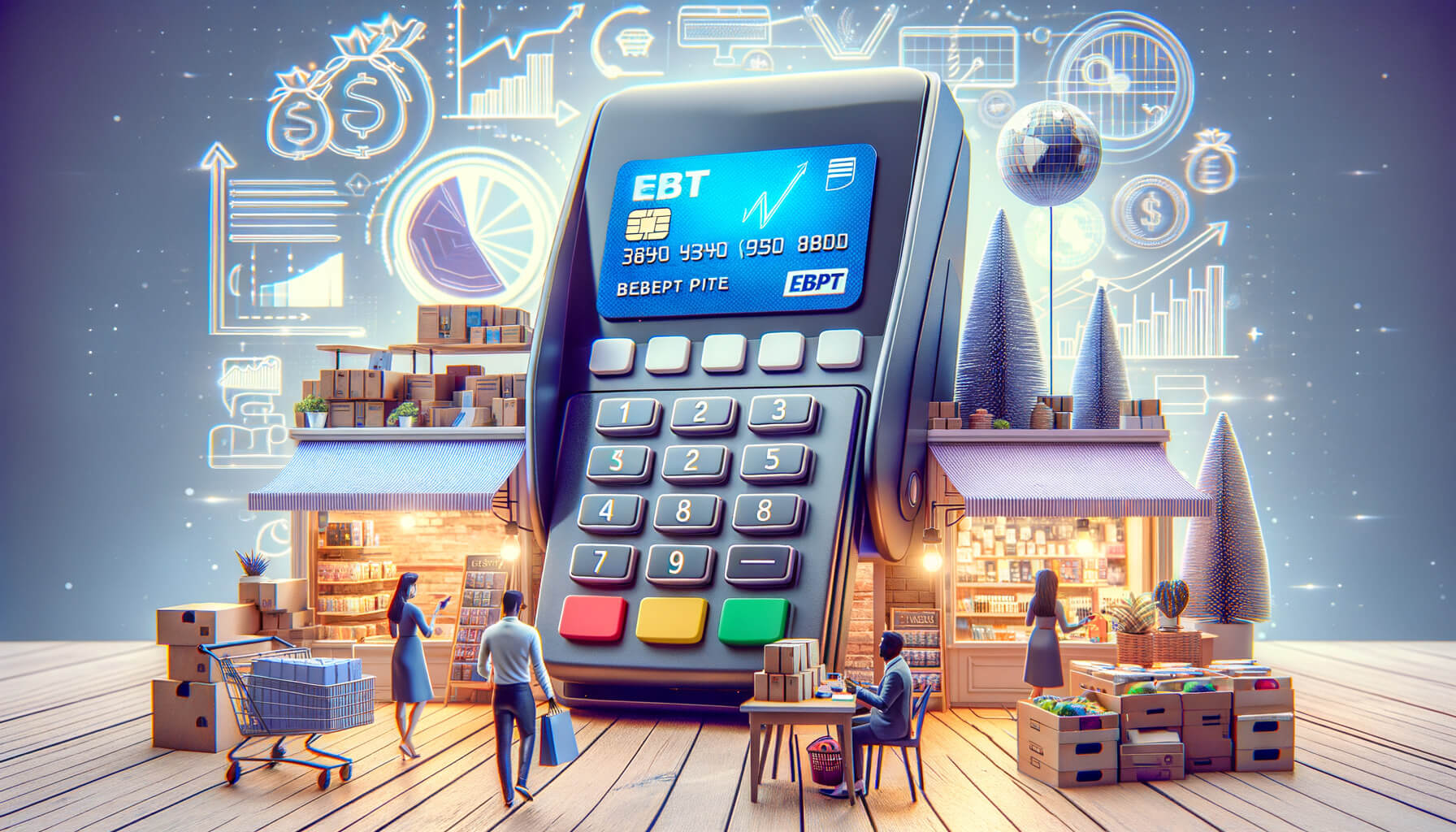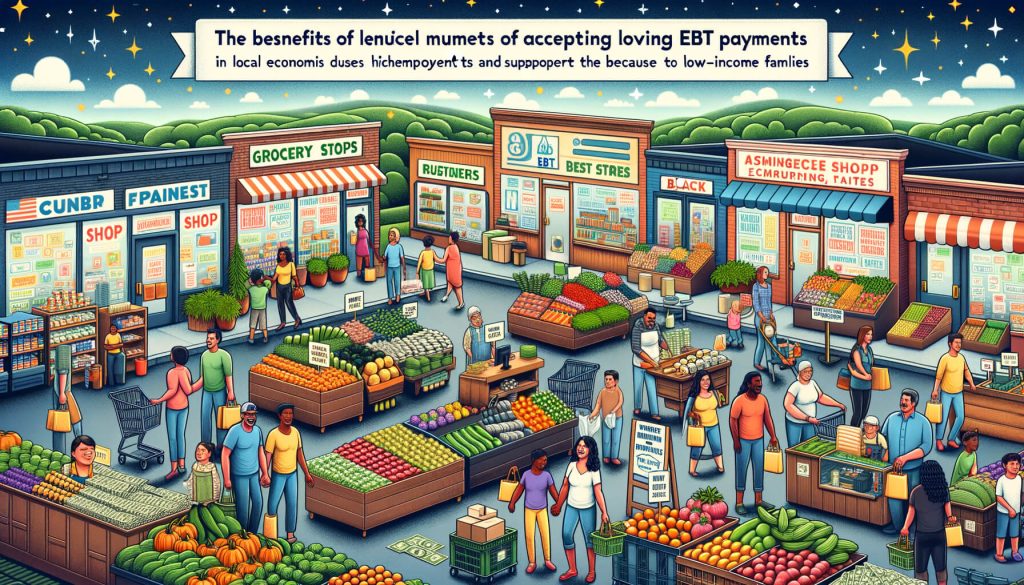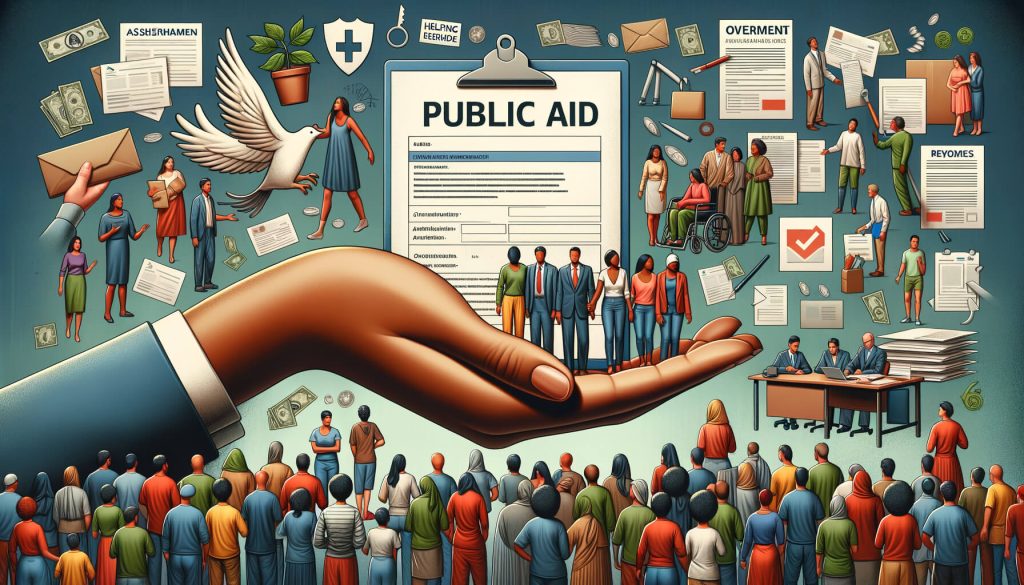
By manoj November 4, 2024
Electronic Benefit Transfer (EBT) is a system that allows recipients of government assistance programs, such as the Supplemental Nutrition Assistance Program (SNAP), to make purchases using a debit card. EBT payments have become increasingly popular in recent years, with millions of Americans relying on these benefits to purchase essential items. As a store owner, accepting EBT payments can bring numerous benefits to your business.
By accepting these forms of payment, stores open their doors to millions of potential customers who depend on these benefits for their daily sustenance. This decision can significantly increase foot traffic and sales, as it provides a necessary service to a community that might otherwise be underserved.
Moreover, the acceptance of EBT payments can enhance a store’s reputation within the community. It signals a commitment to serving and supporting all segments of the population, including those in need. This positive image can attract not only those who use EBT benefits but also socially conscious consumers who prefer to support businesses that contribute to the welfare of the community. Consequently, this can lead to increased loyalty and repeat business from a broad spectrum of customers.
Furthermore, the process of setting up EBT payment payment acceptance is straightforward and supported by both federal and state programs, making it an accessible option for many retailers. The initial investment and ongoing costs associated with accepting EBT payments are often offset by the increased sales volume and customer base expansion. Additionally, the electronic nature of these transactions ensures a secure and efficient checkout process, enhancing the overall shopping experience for all customers.
However, it’s important for retailers to understand the specific requirements and regulations associated with accepting EBT payments, as these can vary by state. Compliance with these rules is crucial to maintain the authorization to accept EBT payments and to avoid potential penalties. Retailers must also invest in training their staff to handle EBT transactions properly, ensuring that the process is seamless for customers using these benefits.
This comprehensive guide will explore the advantages of accepting EBT payments and provide detailed explanations for each subtopic.
Financial Incentives and Reduced Processing Fees: Understanding the Economic Advantages of EBT Acceptance

In the realm of retail and grocery businesses, the decision to accept Electronic Benefit Transfer (EBT) payments can significantly influence your store’s financial health and customer base. EBT, a system that allows recipients of government assistance such as the Supplemental Nutrition Assistance Program (SNAP) to pay for goods using an electronic card system similar to debit cards, has become a pivotal part of the payment landscape.
This section delves into the financial incentives and reduced processing fees associated with EBT acceptance, shedding light on the economic advantages that can benefit your store.
Firstly, one of the most compelling financial incentives for stores to accept EBT payments is the expansion of the customer base. By accommodating EBT payments, stores open their doors to millions of SNAP beneficiaries. This inclusion not only boosts sales but also fosters a sense of community and support, encouraging repeat business. The economic advantage here is twofold: it directly increases revenue through heightened sales and indirectly promotes customer loyalty, which is invaluable in the competitive retail market.
Moreover, the processing fees associated with EBT transactions present another economic benefit. Unlike credit card transactions, which can incur fees ranging from 1.5% to 3.5% per transaction, EBT processing fees are significantly lower or sometimes non-existent. This reduction in transaction costs can lead to considerable savings for retailers, especially those with a high volume of transactions. The lower processing fees associated with EBT payments allow stores to retain a larger portion of their sales revenue, enhancing overall profitability.
Additionally, participating in the EBT program can qualify your store for certain government-funded programs aimed at supporting retailers that serve low-income communities. These programs can offer financial assistance for equipment upgrades, such as point-of-sale (POS) systems capable of processing EBT payments, further reducing the initial costs of EBT acceptance. This not only alleviates the financial burden associated with upgrading technology but also ensures that your store remains competitive and accessible to all segments of the population.
Furthermore, the streamlined nature of EBT transactions can lead to operational efficiencies. EBT payments are processed electronically, which means funds are transferred directly from the government to the retailer’s account, typically within 48 hours. This swift transaction process can improve cash flow and reduce the handling and processing costs associated with cash transactions. The efficiency of EBT transactions also extends to the checkout process, where EBT payments can be processed quickly, reducing wait times and enhancing the customer experience.
How Accepting EBT Payments Benefits Local Economies and Supports Low-Income Families

In the contemporary retail landscape, the decision to accept Electronic Benefit Transfer (EBT) payments in your store can significantly influence not only your business’s growth but also the well-being of the community it serves. This choice goes beyond a mere transactional benefit, extending its impact to strengthening community ties, bolstering local economies, and providing crucial support to low-income families. As we delve into the multifaceted advantages of embracing EBT payments, it becomes evident how this decision can foster a more inclusive and supportive local ecosystem.
Firstly, accepting EBT payments directly contributes to the local economy’s vitality. When stores enable EBT transactions, they essentially open their doors to a broader customer base, including those reliant on government assistance programs such as the Supplemental Nutrition Assistance Program (SNAP).
This inclusivity not only boosts the store’s revenue through increased sales but also ensures that more dollars circulate within the community. Money spent locally tends to stay local, supporting other businesses and services in the area. This circulation of funds within the community can lead to job creation, further investment in local enterprises, and an overall enhancement of the economic health of the area.
Moreover, the decision to accept EBT payments plays a crucial role in supporting low-income families. For many individuals and families participating in SNAP and other assistance programs, access to stores that accept EBT payments is vital. It enables them to purchase necessary groceries and supplies, contributing to their well-being and quality of life.
By accommodating these payment methods, stores become more than just commercial entities; they transform into community pillars that uphold values of inclusivity and support. This accessibility is particularly important in so-called “food deserts,” where low-income families might have limited access to fresh and affordable food options. In such areas, a store that accepts EBT payments can make a significant difference in the community’s health and nutrition.
Furthermore, the acceptance of EBT payments can enhance the store’s reputation and foster a sense of community solidarity. It sends a powerful message that the business is not solely driven by profit but is also committed to serving the needs of all community members, including the most vulnerable.
This can lead to increased customer loyalty and a positive public image, as consumers are increasingly looking to support businesses that contribute to societal well-being. In turn, this can lead to word-of-mouth marketing, social media endorsements, and a stronger customer base that values ethical and community-focused business practices.
Additionally, the technological infrastructure required to process EBT payments can also pave the way for further digital advancements within the store. Investing in modern payment systems not only facilitates the acceptance of EBT cards but can also enhance overall operational efficiency, reduce transaction times, and improve the shopping experience for all customers.
This technological upgrade can be a stepping stone towards adopting other innovative solutions, such as mobile payments and online ordering, keeping the business competitive in a rapidly evolving retail environment.
Increased Customer Base and Sales

One of the primary benefits of accepting EBT payments in your store is the potential to expand your customer base and increase sales. According to the United States Department of Agriculture (USDA), over 42 million Americans received SNAP benefits in 2020. By accepting EBT payments, you open your doors to this large customer segment, allowing them to shop at your store and use their benefits to make purchases.
Accepting EBT payments can also attract customers who may not have considered shopping at your store before. Many individuals and families rely on government assistance programs to meet their basic needs, and by accepting EBT payments, you demonstrate your commitment to serving the community and providing accessible options for those in need.
Furthermore, accepting EBT payments can lead to increased sales. When customers have the option to use their benefits at your store, they are more likely to choose your business over competitors who do not accept EBT payments. This can result in higher foot traffic, increased purchases, and ultimately, a boost in revenue.
Access to Government Assistance Programs

Another significant benefit of accepting EBT payments is the opportunity to tap into government assistance programs. By becoming an authorized EBT retailer, you gain access to a vast network of customers who rely on these programs to purchase groceries and other essential items.
Government assistance programs, such as SNAP, are designed to support low-income individuals and families. By accepting EBT payments, you play a crucial role in ensuring that these individuals have access to the goods they need to maintain a healthy and balanced lifestyle. This not only benefits the recipients but also contributes to the overall well-being of the community.
Additionally, accepting EBT payments can help foster a positive relationship with government agencies. By participating in these programs, you demonstrate your willingness to support and collaborate with government initiatives aimed at assisting vulnerable populations. This can lead to potential partnerships and opportunities for your business in the future.
Enhanced Customer Loyalty and Trust
Accepting EBT payments can significantly enhance customer loyalty and trust. When individuals and families rely on government assistance programs, they often face financial constraints and limited options for purchasing essential items. By accepting EBT payments, you provide a convenient and inclusive shopping experience for these customers, which can foster a sense of loyalty and trust.
Customers who can use their benefits at your store are more likely to become repeat customers. They appreciate the convenience and accessibility you offer, and this can lead to long-term relationships. By consistently meeting their needs and providing a positive shopping experience, you build trust and loyalty, which can translate into increased sales and positive word-of-mouth referrals.
Furthermore, accepting EBT payments demonstrates your commitment to social responsibility. It shows that you are aware of the challenges faced by low-income individuals and families and are actively working to provide them with a dignified shopping experience. This can enhance your store’s reputation and attract customers who value businesses that prioritize social impact.
Competitive Advantage in the Market
Accepting EBT payments can give your store a competitive advantage in the market. While not all businesses accept EBT payments, those that do differentiate themselves from their competitors and attract a unique customer segment.
By offering EBT payment options, you position your store as an inclusive and accessible establishment. This can set you apart from competitors who do not accept EBT payments and attract customers who prioritize shopping at businesses that cater to their specific needs.
Moreover, accepting EBT payments can help you stand out in the eyes of government agencies and organizations that support low-income individuals and families. By actively participating in government assistance programs, you demonstrate your commitment to social responsibility and community welfare. This can lead to positive partnerships and collaborations that further enhance your competitive advantage.
Streamlined Payment Process
Accepting EBT payments can streamline your payment process and improve operational efficiency. EBT payments are processed electronically, eliminating the need for manual handling of paper vouchers or checks. This not only saves time but also reduces the risk of errors and fraud.
With an electronic payment system in place, you can process EBT transactions quickly and accurately. This allows you to serve customers more efficiently, reducing wait times and improving overall customer satisfaction. Additionally, electronic payments simplify the reconciliation process, making it easier to track and manage your store’s financial transactions.
Furthermore, accepting EBT payments can integrate seamlessly with your existing point-of-sale (POS) system. Many modern POS systems offer EBT processing capabilities, allowing you to accept EBT payments alongside other payment methods. This integration ensures a smooth and cohesive payment experience for both your customers and your staff.
Increased Revenue Opportunities
Accepting EBT payments can open up new revenue opportunities for your store. In addition to SNAP benefits, EBT cards can also be used for other government assistance programs, such as the Women, Infants, and Children (WIC) program. By accepting EBT payments, you can attract customers who participate in these programs and offer them a convenient shopping experience.
Furthermore, accepting EBT payments can lead to increased sales of eligible items. SNAP benefits can only be used to purchase certain food items, such as fruits, vegetables, dairy products, and meats. By stocking a wide variety of these eligible items, you can cater to EBT customers and increase your sales in these categories.
Additionally, accepting EBT payments can encourage customers to spend more in your store. When individuals have the option to use their benefits, they may choose to purchase additional items or higher-priced products. This can result in larger transactions and a boost in revenue for your business.
Compliance with Legal Requirements
Accepting EBT payments ensures compliance with legal requirements and regulations. The USDA oversees the administration of government assistance programs, including SNAP, and sets guidelines for authorized EBT retailers. By becoming an authorized retailer, you demonstrate your commitment to adhering to these regulations and providing a secure and reliable payment option for EBT recipients.
Compliance with legal requirements not only protects your business from potential penalties or legal issues but also builds trust with customers and government agencies. It shows that you operate your store ethically and in accordance with established standards. This can enhance your reputation and attract customers who value businesses that prioritize compliance and transparency.
Furthermore, accepting EBT payments can help you stay informed about any updates or changes in government assistance programs. The USDA regularly communicates with authorized retailers, providing important information and resources to ensure compliance. This allows you to stay up-to-date with program requirements and make any necessary adjustments to your operations.
Addressing Common Concerns and Misconceptions
Accepting EBT payments may come with common concerns and misconceptions. It is important to address these concerns to ensure a smooth transition and maximize the benefits of accepting EBT payments in your store.
One common concern is the perceived complexity of the EBT payment process. Some store owners may worry about the additional training and equipment required to accept EBT payments. However, modern POS systems often have built-in EBT processing capabilities, making it easy to integrate this payment option into your existing operations. Additionally, the USDA provides resources and support to authorized retailers, including training materials and technical assistance.
Another concern is the potential for fraud or abuse of EBT benefits. While it is essential to remain vigilant and implement appropriate security measures, it is important to note that the USDA has implemented strict regulations and monitoring systems to prevent misuse of benefits. By following the guidelines provided by the USDA and maintaining proper record-keeping practices, you can minimize the risk of fraud and ensure the integrity of the EBT payment process.
FAQs
Q1: How do I become an authorized EBT retailer?
To become an authorized EBT retailer, you need to apply with the USDA. The application process involves completing the necessary forms, providing required documentation, and meeting specific eligibility criteria. The USDA will review your application and, if approved, provide you with the necessary authorization to accept EBT payments.
Q2: Can I accept EBT payments if I only sell non-food items?
EBT payments are primarily intended for the purchase of eligible food items. However, some states allow EBT payments to be used for non-food items, such as personal care products or household supplies. It is important to check the regulations specific to your state to determine if you can accept EBT payments for non-food items.
Q3: How long does it take to process EBT payments?
EBT payments are processed electronically and typically take a similar amount of time as other debit card transactions. The exact processing time may vary depending on your POS system and network connectivity. However, with modern technology, EBT transactions are generally processed quickly and efficiently.
Q4: Can I offer discounts or promotions for EBT customers?
While the USDA prohibits offering discounts or promotions exclusively for EBT customers, you can offer general discounts or promotions that apply to all customers, including those using EBT payments. It is important to ensure that your promotions comply with USDA guidelines and do not discriminate against EBT customers.
Q5: Can I refuse EBT payments if I am an authorized retailer?
As an authorized EBT retailer, you are required to accept EBT payments from eligible customers. Refusing EBT payments without valid reasons can result in penalties or the revocation of your authorization. It is important to familiarize yourself with the USDA guidelines and comply with the requirements of being an authorized retailer.
Conclusion
Accepting EBT payments in your store can bring numerous benefits, including increased customer base and sales, access to government assistance programs, enhanced customer loyalty and trust, competitive advantage in the market, streamlined payment process, increased revenue opportunities, compliance with legal requirements, and the ability to address common concerns and misconceptions.
By becoming an authorized EBT retailer, you demonstrate your commitment to serving the community and providing accessible options for those in need. You tap into a vast network of customers who rely on government assistance programs and gain the opportunity to foster positive relationships with government agencies.
Accepting EBT payments can streamline your payment process, improve operational efficiency, and open up new revenue opportunities. It ensures compliance with legal requirements and regulations, building trust with customers and government agencies. By addressing common concerns and misconceptions, you can ensure a smooth transition and maximize the benefits of accepting EBT payments in your store.
In conclusion, accepting EBT payments is not only a sound business decision but also a way to make a positive impact on the lives of individuals and families who rely on government assistance programs. By embracing this payment option, you contribute to a more inclusive and equitable society while reaping the benefits of increased sales, customer loyalty, and competitive advantage in the market.